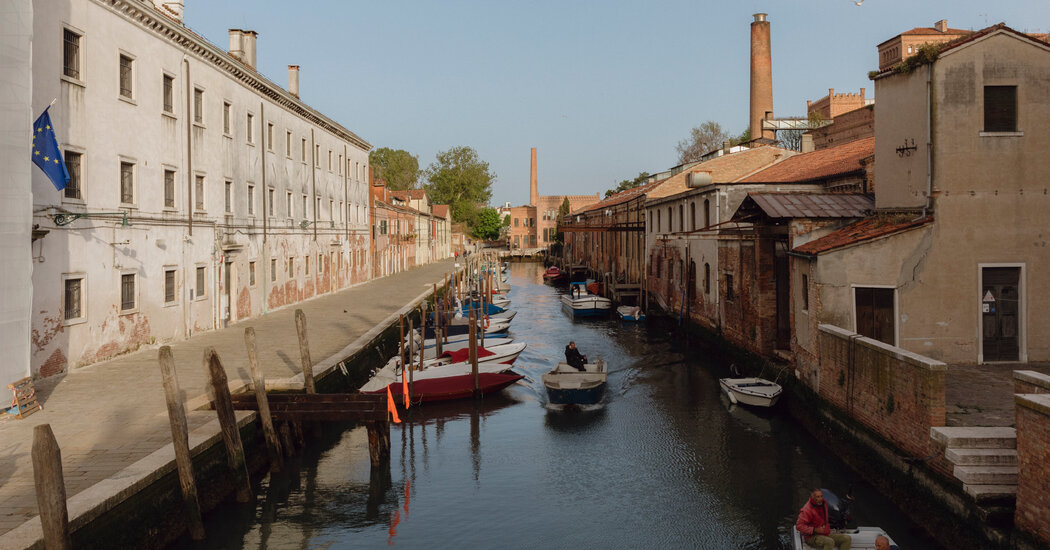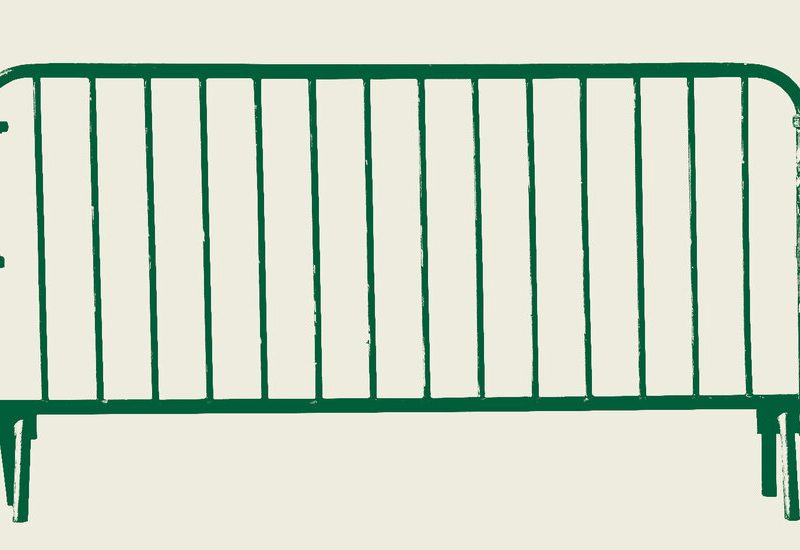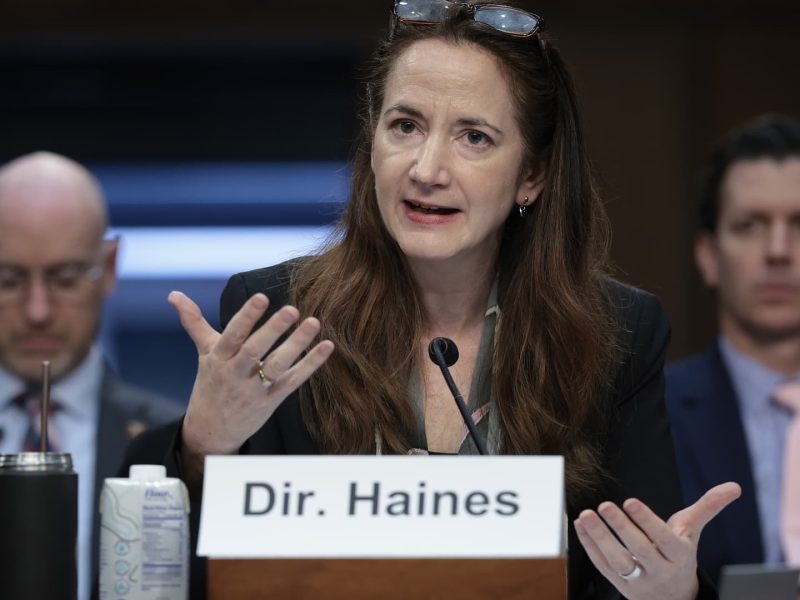An early version of “Dovecote,” a short, nearly wordless film directed by Marco Perego for exhibition at the Biennale, has a scene that tracks a man in uniform as he drives a motorboat through a morning in Venice. The city is showing off its glories, with palazzos and domed churches reflected in the canals, a blue sky above. The film shifts to black and white as the action moves inside a building less adorned than the ones the man has boated past, but grand, even so. It’s his workplace, the Giudecca women’s prison.
Perego said in a telephone interview that he wanted to contrast “the beauty of Venice, one of the most beautiful places in the world, then this silent place inside.” He added, “I wanted to ask the question of what freedom means.”
Once inside the prison, the film focuses on an unnamed character played by Perego’s wife, the actor Zoe Saldaña, who is to be released that day. Her companions are played by 20 actual prisoners.
During the Biennale, the film will be exhibited in the prison’s visitation room, as part of the Vatican Pavilion, which is being hosted throughout the building. The show will also feature work in various media by nine other artists, shown in spaces including the prison’s courtyards, chapel and cafeteria.
The Holy See first participated in the Biennale in 2013, but this is its first year showing at the prison. Pope Francis is expected to become the first pope to visit the Biennale, touching down by helicopter in the prison courtyard on April 28 before heading to the Piazza San Marco to celebrate Mass, according to Cardinal José Tolentino de Mendonça, the prefect who leads the Vatican’s department of culture and education.
In an email, Giovanni Russo, the head of the Department of Penitentiary Administration in the Italian Ministry of Justice, said he was approached to host the Vatican Pavilion by the cardinal, who is also a poet and essayist. Russo explained, “When the cardinal made this proposal to us, I said to myself, I would be committing a sin, I would be violating my duties as a magistrate, if I did not accept this request immediately.”
With My Eyes is the title of the pavilion, curated by Bruno Racine, the director of Venice’s Palazzo Grassi museum, and Chiara Parisi, the director of the Centre Pompidou-Metz. “It conveys the message that we mustn’t only be spectators, but also witnesses,” Racine wrote in an email. He later elaborated,“A spectator is passive, while a witness conveys a message after having seen.”
One piece, by the Syrian-Lebanese artist Simone Fattal, puts excerpts from pieces written by inmates onto plaques made of hardened lava. One reads, in Italian, “In this place, there is no armor.” Another work has portraits of the prisoners as girls and young women by the French painter Claire Tabouret, based on photos supplied to her. The French hip-hop choreographer Bintou Dembélé has put together a dance to be performed, in part, by inmates. Prisoners will also serve as docents, leading visitors through the exhibits. (The guards also play a role: Visitors leave their cellphones with a guard upon entering, and guards accompany the visitors and prisoners throughout the space.)
Some 80 inmates live at the Giudecca, and Racine estimated that almost all of them would participate in the exhibition in one way or another.
The building’s past lives also feature in some of the pieces to be exhibited. Constructed in the 13th century, the structure became a convent in the 16th century, and then a hospital in the early 19th century, when the French ran Venice. It was next a military prison under the Austrians later that century, before becoming a civilian prison under the Italians in the 1900s.
The building’s current name, the Convertite, speaks of the conversion by some prostitutes who took holy orders, according to Dennis Romano, the author of “Venice: The Remarkable History of the Lagoon City.” In a phone interview, he said: “It was a convent dedicated to Mary Magdalene, which, of course, made perfect sense for an institution for reformed prostitutes, that moved in sometime in the 1540s. By 1562, it had become a cloistered order, one where they weren’t supposed to leave.”
For the Vatican Pavilion, the Brazilian artist Sonia Gomes plans to hang up one of her fabric pieces high in the chapel where some of the prisoners worship, attaching it between the balconies and the confessionals. She explained in a statement that she hoped to connect “the original function of the place, the Baroque convent for ‘reconverted’ women with the current life of the prison house, and the stories of women from all over the world.”
In Perego’s film, the camera visits another of the spaces used by prisoners, the dormitory, where Saldaña’s character and an inmate friend share a wordless farewell on a camp bed. Saldaña said: “You are wondering are they lovers, are they sisters, are they best friends. There is love, there’s a bond, and there’s a sadness to know that they’re not going to be together again.”
Perego said, “When we were shooting, I said, ‘Think you’re leaving home.’” Surrounded by actual prisoners, Saldaña’s character revisits familiar places, like the in-house tailor shop, where she has worked, and the shower room; gets her coat from the guard; and walks into an arcaded courtyard, where — from a balcony — the women look out at her and bang their tin mugs on a ledge to celebrate her release.
The Biennale show will also highlight some aspects of the way Italian authorities run this prison. “Exhibiting in a prison means showing a reality that is foreign to most people, who would never enter that space if it wasn’t for the artworks attracting them,” Parisi wrote in an email.
The penitentiary also has gardens, and the organic produce grown there by the prisoners (who are paid for their work) is sold to the public, and toiletries made in-house go into the bathrooms of some top Venetian hotels. A local group of volunteers, Rio Terà dei Pensieri, helped jump-start these enterprises.
“There is a real tradition of paternalism to Venetian charity, “ Romano said. “The charitable institutions of the period when this convent was founded thought that you ought to give people a trade.”
Another nod to the institution’s convent past is the inclusion of silk-screened prints by Corita Kent, a longtime Catholic nun and progressive activist who died in 1986. In an email, Parisi said that Kent’s work was included for its combination of “sacred texts, poetry, statements and Pop imagery, in works that challenge convention.”
Kent’s appearance in the Vatican show represents a posthumous rehabilitation of sorts, since, in her lifetime, an American cardinal, James McIntyre, denounced her silk screens as blasphemous.
Another artist in the show, Maurizio Cattelan, provoked controversy in Catholic circles with a work he made in 1999, a statue of Pope John Paul II felled by a meteorite. Cattelan’s contribution to the Vatican Pavilion is a sculpture of another human on the ground, an unidentified man, sleeping on the pavement with a dog for a companion.
The decision to involve inmates extensively in most of the pieces in this exhibition, Racine said, was taken after consultation with a prison psychologist. “The project is a unique opportunity for the inmates to get a form of recognition,” he wrote in an email. “The project aims at recognizing the dignity of the inmates without forgetting that these women are serving long sentences.”
Perego said he and his co-writer, Alexander Dinelaris, called their short film “Dovecote” after the traditional small houses built for domesticated pigeons. Perego compared the inmates to these birds, noting that they both often go unnoticed. “When you interview the majority of these women, outside, they feel completely invisible,” he said.
A few weeks after her visit for the shoot, Saldaña recalled: “The inmates are not allowed to have cellphones, so the moment they saw me with my cellphone, they kept saying, ‘Take a picture of me.’ Not only take a picture with me, but of me. They want to be seen, they want to be remembered.”



